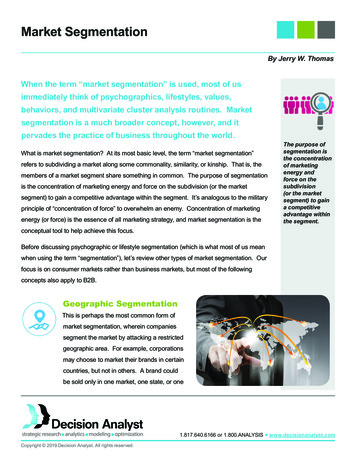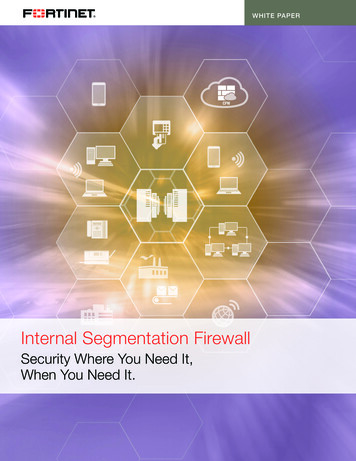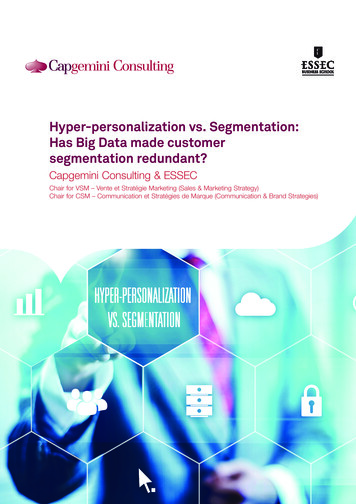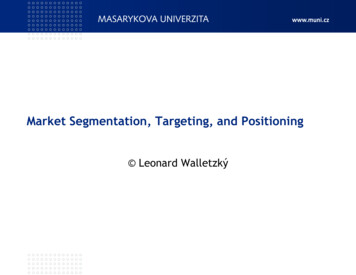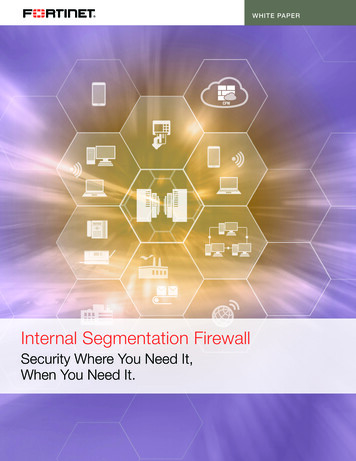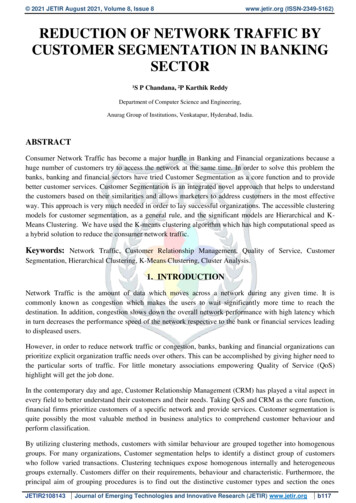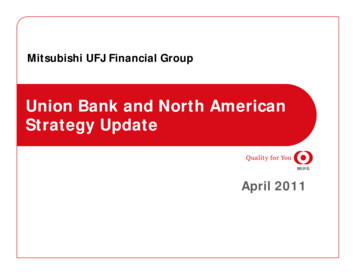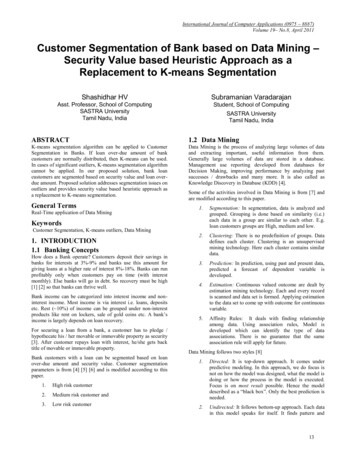
Transcription
International Journal of Computer Applications (0975 – 8887)Volume 19– No.8, April 2011Customer Segmentation of Bank based on Data Mining –Security Value based Heuristic Approach as aReplacement to K-means SegmentationShashidhar HVSubramanian VaradarajanAsst. Professor, School of ComputingSASTRA UniversityTamil Nadu, IndiaABSTRACTK-means segmentation algorithm can be applied to CustomerSegmentation in Banks. If loan over-due amount of bankcustomers are normally distributed, then K-means can be used.In cases of significant outliers, K-means segmentation algorithmcannot be applied. In our proposed solution, bank loancustomers are segmented based on security value and loan overdue amount. Proposed solution addresses segmentation issues onoutliers and provides security value based heuristic approach asa replacement to K-means segmentation.General TermsReal-Time application of Data MiningStudent, School of ComputingSASTRA UniversityTamil Nadu, India1.2 Data MiningData Mining is the process of analyzing large volumes of dataand extracting important, useful information from them.Generally large volumes of data are stored in a database.Management use reporting developed from databases forDecision Making, improving performance by analyzing pastsuccesses / drawbacks and many more. It is also called asKnowledge Discovery in Database (KDD) [4].Some of the activities involved in Data Mining is from [7] andare modified according to this paper.1.Segmentation: In segmentation, data is analyzed andgrouped. Grouping is done based on similarity (i.e.)each data in a group are similar to each other. E.g.loan customers groups are High, medium and low.2.Clustering: There is no predefinition of groups. Datadefines each cluster. Clustering is an unsupervisedmining technology. Here each cluster contains similardata.3.Prediction: In prediction, using past and present data,predicted a forecast of dependent variable isdeveloped.4.Estimation: Continuous valued outcome are dealt byestimation mining technology. Each and every recordis scanned and data set is formed. Applying estimationto the data set to come up with outcome for continuousvariable.5.Affinity Rules: It deals with finding relationshipamong data. Using association rules, Model isdeveloped which can identify the type of dataassociations. There is no guarantee that the sameassociation rule will apply for future.KeywordsCustomer Segmentation, K-means outliers, Data Mining1. INTRODUCTION1.1 Banking ConceptsHow does a Bank operate? Customers deposit their savings inbanks for interests at 3%-9% and banks use this amount forgiving loans at a higher rate of interest 8%-18%. Banks can runprofitably only when customers pay on time (with interestmonthly). Else banks will go in debt. So recovery must be high[1] [2] so that banks can thrive well.Bank income can be categorized into interest income and noninterest income. Most income is via interest i.e. loans, depositsetc. Rest ( 10%) of income can be grouped under non-interestproducts like rent on lockers, sale of gold coins etc. A bank’sincome is largely depends on loan recovery.For securing a loan from a bank, a customer has to pledge /hypothecate his / her movable or immovable property as security[3]. After customer repays loan with interest, he/she gets backtitle of movable or immovable property.Bank customers with a loan can be segmented based on loanover-due amount and security value. Customer segmentationparameters is from [4] [5] [6] and is modified according to thispaper.1.High risk customer2.Medium risk customer and3.Low risk customerData Mining follows two styles [8]1.Directed: It is top-down approach. It comes underpredictive modeling. In this approach, we do focus isnot on how the model was designed, what the model isdoing or how the process in the model is executed.Focus is on most result possible. Hence the modeldescribed as a “black box”. Only the best prediction isneeded.2.Undirected: It follows bottom-up approach. Each datain this model speaks for itself. It finds pattern and13
International Journal of Computer Applications (0975 – 8887)Volume 19– No.8, April 2011leaves the choice to the user, whether the resultantpattern is valid or not. In this approach, working of themodel is taken care. To understand about the data, weneed to know about the model. Hence the model is asemi-transparent box.1.Assign first k loan over-due amount (here k 2) tomean values m1, m2.2.Assign each loan over-due amount to that segmentwhich is having its nearest mean.The existing system in bank loan customers’ segmentation isbased on loan over-due amount using K-means.3.Calculate new mean for n segments (here n 2) untilconvergence criteria are met.2.1 K-means SegmentationConvergence Criteria: Old mean and new mean of eachsegment are analyzed. If the two values for all segments areequal, then convergence criteria are met.2. EXISTING SYSTEMConsider there are N- loan customers in bank, where N is verylarge. They need to be segmented into high, medium and lowrisk customers based on their loan over-due amount.K-means segmentation is an iterative process. Initially, we mustdecide on number of customer segments. Let’s consider a casewhere we segment customers into two categories.First, we need to initialize mean values. Number of mean valuesneeded is equal to the number of segments. Mean values m1, m2 mn takes first K input values, where n, k is number ofsegments.Algorithm:There are three ways of assigning initial mean values1.First k loan over-due values2.Randomly take k loan over-due values3.Arbitrarily assignedAlgorithm is from [4] [5] [9] [10] and is changed accordingto this paper. In this paper, first way of assigning meanvalue is followed.Figure 1: K-means Customer Segmentation (1)First case: Let’s assume that the loan over-due amount isnormally distributed.Figure 1 shows that loan customers are segmented adequatelybased on loan over-due amount.In the above figure 1, customer’s loan over-due amount variesnormally from single digit to lakhs. Since the distribution isnormal, loan over-due amount are segmented adequately.Segment 1 contains customers’ loan over-due amount rangingfrom 48thousand to lakhs and they belong to high risk customersgroup.Segment 2 contains customers’ loan over-due amount rangingfrom single digit to 48thousand and they belong to low riskcustomer group.Thus, when bank customers’ loan over-due amount is normallydistributed, K-means can be used to segment customers.14
International Journal of Computer Applications (0975 – 8887)Volume 19– No.8, April 2011Figure 2: K-means Customer Segmentation (2)2.2 Issues found in K-means Segmentationon OutliersSecond case: Let’s assume that a few customers have a verylarge loan over-due amount when compared to other customers(Outliers).Figure 2 shows that loan customers are not segmented properly.In the above figure 2, outliers exist i.e. customers’ loan over-dueamount varies from single digit to lakhs and very few in crores.Segment 2 contains outlier i.e. 6 crores and Segment 1 containsrest of the input values, which means no optimal segmentationtakes placeThus, when very few customers (Outliers) have very large loanover-due amounts compared to other customers, then optimalsegments are not generatedThis is a practical real-time issue which could arise when loancustomers of bank are segmented using K-means algorithm.When over-due loan amount is not evenly distributed (Outliers),segments generated using K-means could be unreliable.New proposed system addresses segmentation issues on outliersin the previous case and provides optimum segments3. PROPOSED SYSTEMIn the proposed system, bank loan customers are segmentedbased on security value and loan over-due amount.3.1 Customer SegmentationLet’s assume N- loan customers in bank, where N is very large.To segment customers into high risk, medium risk, and low riskcustomers, we propose - developing segmentation using securityvalue and loan over-due amount.3.1.1 Loan Customer DatabaseCustomer Database is from [9] and modified according to loancustomers. Customer Database consists of following tables:customer profile, customer identifications, mode of operation,products, rate of interest, account opening, loan master,transaction, codes.Figure 3: Customers Database15
International Journal of Computer Applications (0975 – 8887)Volume 19– No.8, April 2011Loan master table is vital to customer segmentation. Loanmaster table contains following fields: Customer informationfile no., Customer name, Loan account no., Product name,Security value, Loan over-due amount.3.1.2 AlgorithmCustomer Database is given above (Figure 3).Figure 3 shows all the fields and first 10 loan customer recordsin loan master table.Customers are segmented into high risk, low risk and mediumrisk. Instead of taking only the loan over-due amount, we canfactor both security value and loan over-due amount intoconsideration for customer segmentation. This will make thecustomer segmentation more effective.Else if security value due loan amt, then customer is highrisk.Analysis & Grouping:Repeat the above analysis for all loan customers and groupthem. Segment 1: High Risk, Segment 2: Low Risk, Segment 3:Medium RiskCustomer loan over-due amount, security amount are retrievedfrom the database.If security value (2 * due loan amt), then customer is lowrisk.Else if security value (2 * due loan amt) and security value due loan amt, then customer is medium risk.Update the Database with creation of high risk, low risk, andmedium risk tables.StartRetrieve customers’security value andloan over-due amountCalculate2* loan over-due amountIs security value 2 * loan overdue amountCustomer is Low riskStopYNOIs security value loan over-dueamountCustomer is High riskStopYNOIs security value 2 * loan over-due amtand security value loan over-due amtYCustomer is MediumriskStopFigure 4: Flow Chart – Analysis and Grouping for single customer16
International Journal of Computer Applications (0975 – 8887)Volume 19– No.8, April 2011Figure 4 describes pictorially/graphically, analysis and groupingprocess for single customer in proposed segmentation algorithm.Figure 5 shows newly created 3 tables: high risk, low risk,medium risk and all the other tables in customer Database.Vital tables are highlighted.Tablescif nocust nameloan acc noaccounts 11019p a constructionmtl0031020xyz enterprisessi0011023agarwalhla007codescustomer identificationcustomer profilehigh risklow riskmedium riskmode of operationproducts1027sky fabricatorsssi004rate of Figure 5: Customer Database tables (after Segmentation)Figure 6: High Risk customers (Group 1)cif nocust nameloan acc nocif nocust nameloan acc 014shanmugametl0021013abc 0031018jacobhla0051017ravihla0041021mannar cossi0031025durga societyamt0031022roy guptahla0061029ss matric schoolmtl0041024rasi and cossi0041030zion industryssi0051026manikandanhla0081034rainbow bhellsi0041036saradas textilessi005Figure 7: Low Risk customers (Group 2)Figure 8: Medium Risk customers (Group 3)Customer Database is created with significant outliers i.e.customers’ loan over-due amount varies from single digit tolakhs and few in crores.Customer Database shows that loan over-due amount is widelydistributed i.e. Outlier is taken into consideration.Figure 6 shows the content in high risk customer table Customer segmented group 1Figure 7 shows the content in low risk customer table –Customer segmented group 217
International Journal of Computer Applications (0975 – 8887)Volume 19– No.8, April 2011based on non-performing asset and credit risk factors to bettersegment customers.5. REFERENCESHLH - High RiskM - Medium RiskML - Low RiskFigure 9: Pie Chart: Segmented CustomersFigure 8 shows the content in medium risk customer table Customer segmented group 3Figure 9 describes segmented customers - pictorially/graphicallySecurity based heuristic approach of customer segmentation,will result 3 tables as shown above. High risk, low risk andmedium risk tables shows that loan over-due amount aresegmented adequately. Each data in a particular group i.e. alldata in high risk/ low risk/ medium risk group are similar to eachother i.e. optimum segments are generated.Thus, when very few customers (Outliers) have very large loanover-due amounts compared to other customers, security basedheuristic can be used to segment customers’.In this algorithm, security value and loan over-due amount areused to segment customers effectively. This system answers theissue found in k-means segmentation on outliers. Proposedsystem will thus segment customers even when outliers existsi.e. when loan over-due amount are unevenly distributed. Thissystem will give optimum perfection in customer segmentation.4. CONCLUSIONThe proposed system segments customers effectively based onsecurity value and loan over-due amount. The security valuebased heuristic addresses the outlier issue with K-meanssegmentation. Another approach to overcome the issue onoutliers is a) To separate the outliers from master table andgenerate K-means segmentation on remaining data b) Ourproposed security value based heuristic can be applied on theoutlier population, thus segmenting the overall population in twosteps. Future work may concentrate on customer segmentation[1] S. Peter and Rose, “Commercial Bank Management,” 4th,Liu Z.Y. Translator, China Machine Press, Beijing, China,2001.[2] Xiaohua Hu, “A Data Mining Approach for Retailing BankCustomer Attrition Analysis,” Kluwer, Applied Intelligence22, pp47-60, 2005[3] Lu Haiyan, Fu YingLiang and Xing Cuifang, “DataWarehouse in the banking customer relationshipmanagement application,” Journal of Dalian MaritimeUniversity vol.33, Jun. 2007, pp.181-186.[4] Shuxia Ren, Qiming Sun and Yuguang Shi, “CustomerSegmentation of Bank Based on Data Warehouse and DataMining,” IEEE, 2010.[5] Wang Yinghui, “Improvement Research of CustomerSegmentation in Knowledge Intensive Business Services”IEEE, 2010.[6] Ganglong Duan, Zhiwen Huang and Jianren Wang,“Extreme Learning Machine for Bank ClientsClassification,” IEEE, 2009.[7] Zhang Rong, “An application of Data warehouse and datamining in customer relationship management of bank,”Computer and Information Technology, Feb. 2006, pp.7981.[8] Zhang Guozheng, “Customer segmentation in customerrelationship management based on data mining,”Commercial Research, vol.345, 2006(13), pp153-155.[9] Wei Li, Xuemei Wu, Yayun Sun and Quanju Zhang,“Credit Card Customer Segmentation and Target MarketingBased on Data Mining,” IEEE, 2010.[10] Wu, J., and Lin, Z., “Research on customer segmentationmodel by clustering,” ACM International ConferenceProceeding Series, 2005.18
Loan master table is vital to customer segmentation. Loan master table contains following fields: Customer information file no., Customer name, Loan account no., Product name, Security value, Loan over-due amount. Customer Database is given above (Figure 3). Figure 3 shows all the fields and first 10 loan customer records
